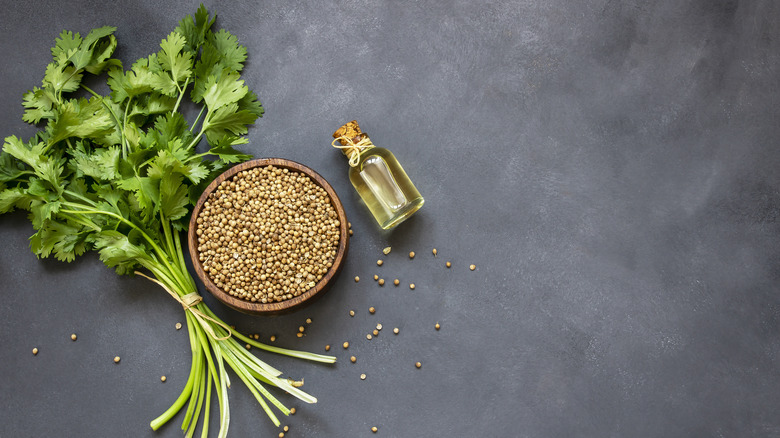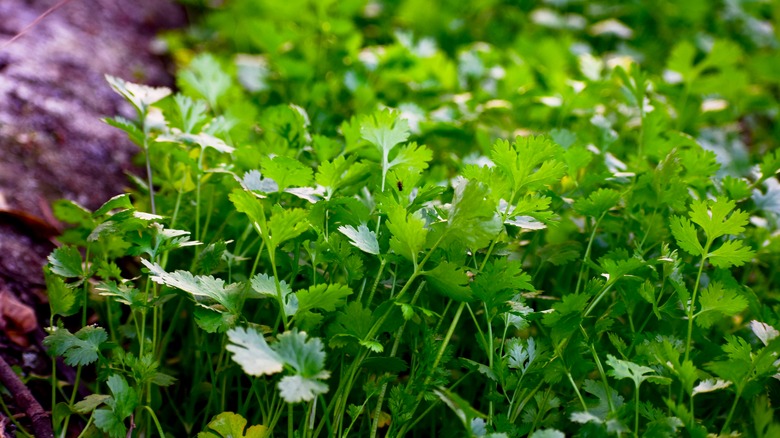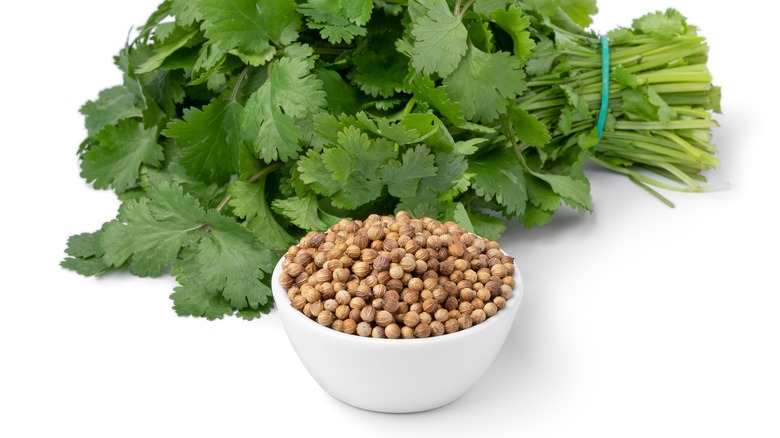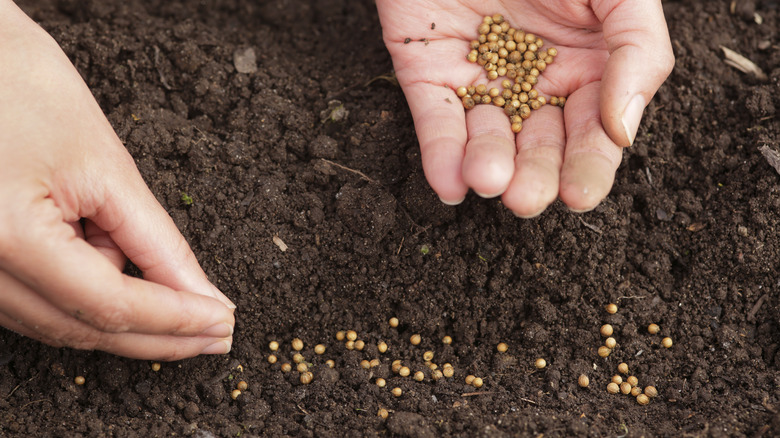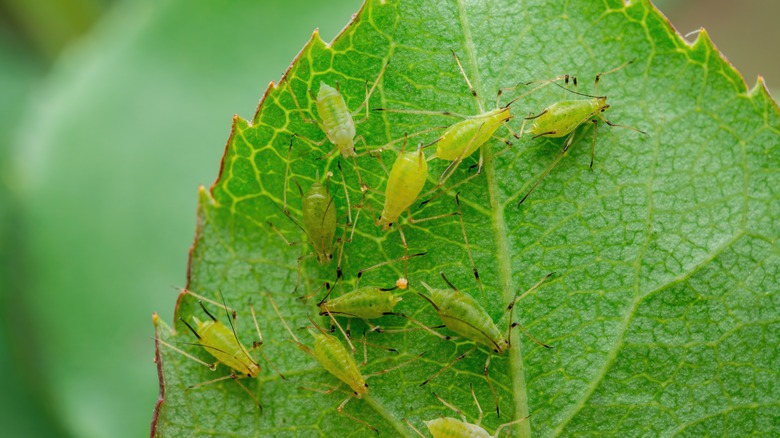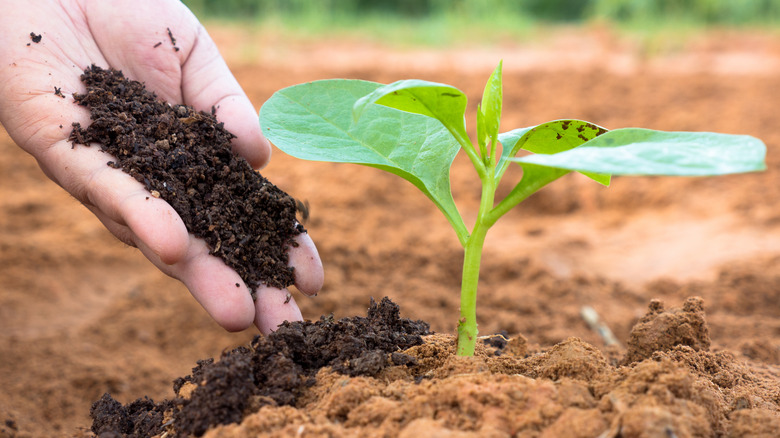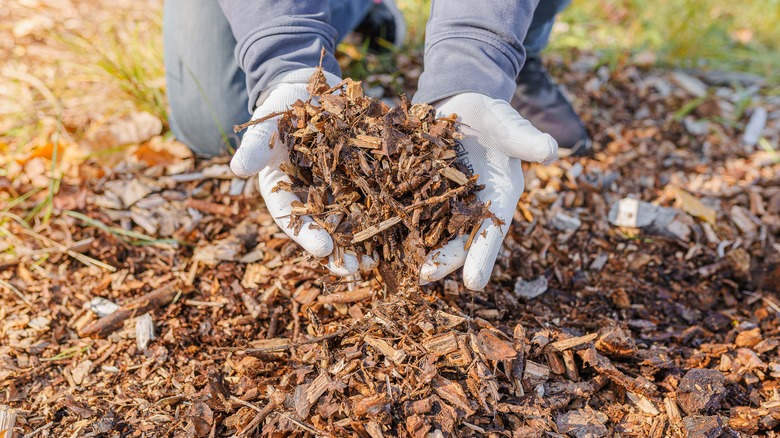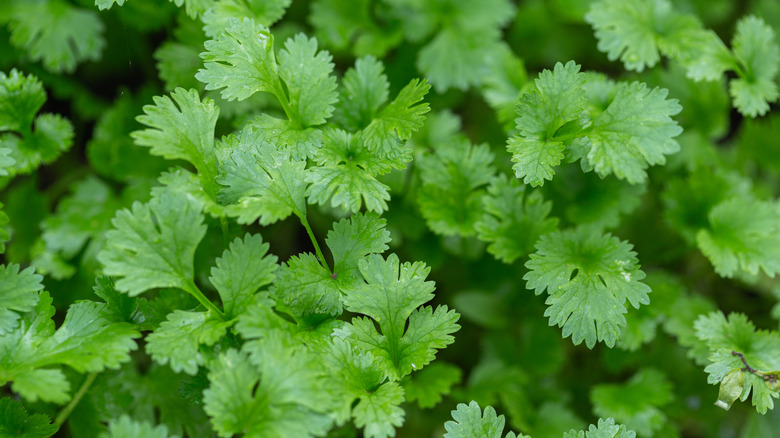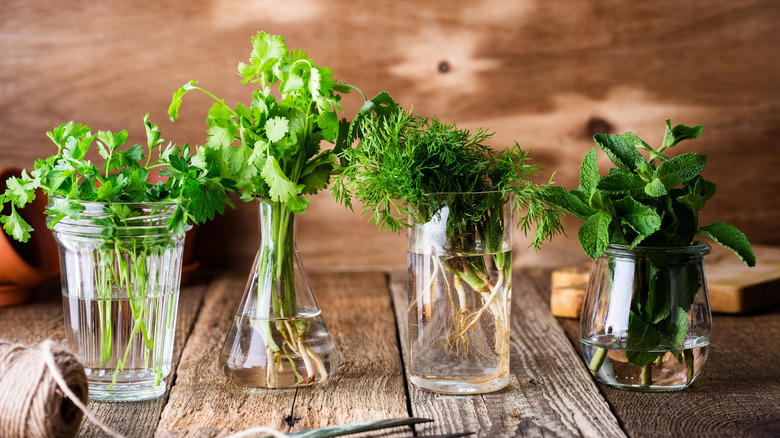How To Grow And Care For Your Cilantro Plant
Crowned "Herb of the Year" by the International Herb Association in 2017, Coriandrum sativum – better known by its street name, cilantro — is a two-for-one herb and spice. To avoid bolting — the process whereby a plant quickly grows into a flower — one key thing to note is that coriander does well in cooler seasons, such as spring or fall.
Despite the plant being prone to bolting in warmer weather, a few hacks guide you through growing this herb, even in more tropical climes. One way to grow and keep your plant healthy and fruitful is to grow it alongside similar but taller plants, as the shade cools down the soil and allows the plants to thrive a little better. Another great hack is to be mindful of the type of soil you're planting your herb in. When planting seeds, many often don't consider the importance of soil quality or fertilizer. It's important to ensure both of these things are of great quality and the right type for the herb you are trying to harvest. There are many simple ways to grow and care for your cilantro plant. Let's dive into a few.
Plant it in the cooler months
Yes, cilantro seeds favor cooler seasons like spring and fall, when the temperatures are lower and the sun isn't as harsh. In hotter months, such as the height of summer, cilantro is more likely to bolt, meaning the seeds flower too quickly, giving you little access to the herb. You'll get a successful harvest by planting in the cooler months.
You can also do some other things to prolong your harvest season. Sowing a few seeds every two weeks will help you stagger its growth, giving you more weeks of herbs. You can also create shade for the plant, blocking it from direct sunlight and helping it grow at an appropriate pace. A way to achieve this is by planting taller companion plants around your cilantro. Tomato is a great companion plant because it requires the same amount of soil moisture. Furthermore, tomatoes thrive in hotter temperatures and grow taller than the herb, providing much-needed shade without competing for nutrients.
Keep the seeds apart when planting
Cilantro seeds benefit from space when planted, and not just because the herbs tend to grow bushy. When planting your first cilantro seeds, it's advisable to space them 2 inches apart in rows that are 1 foot apart. Cilantro seeds aren't too fussy but need a fair bit of area to avoid overcrowding. This is vital if your primary goal is to use them for their leaves — the herbs themselves.
By spacing them apart this way, you're more likely to get fuller, healthier leaves thanks to the generous airflow the growing seeds will enjoy. Additionally, the seeds don't need to compete for nutrients from the soil when spaced apart. The soil, in turn, is well-drained and can provide enough moisture to all the seeds and their roots. Another thing to note is that cilantro seeds don't need to be planted too deep into the soil, so place them 1/2 an inch into the ground, and they'll reward you with beautiful sprouts.
Make sure the soil is moist
When starting your garden, it's vital to consider the type of soil that works best for your seed. In the case of cilantro, your primary focus should be ensuring your soil has the right amount of moisture. A well-drained soil is the goal. Do not water to create puddles in your ground, as this will drown your seeds. In the first few weeks of germination, it's important to water your seeds lightly but frequently, providing 1/2 a gallon of water weekly for the seed. As it begins to sprout, water less often to avoid over-watering. Doing so can lead to wilting and other diseases such as fungal wilt, root rot, and mildew due to clogged soil.
There are factors to consider when deciding how often to water your cilantro plants. Firstly, are your seeds planted directly in the soil or pot? If your cilantro seeds are planted directly in the ground outside, you can get away with watering them every few days. These plants need more water since the direct sunlight dries them out, and they can draw moisture directly from the ground when required. If they grow in a pot, they need to be watered less frequently since there is no direct sunlight to dry them.
Beware of pests
Two main threats to your herbs are aphids, like blackflies and greenflies, and red spider mites. Aphids attack in groups. They can usually be found on the leaves of your herbs, sucking the sap from the plant and leaving behind a secretion that ants feed on. The entire process can be traumatic for your cilantro plants, rendering them all but useless to you. However, if the infestation turns out to be mild, you can either flick them off with your hands, spray them down with a hose, or — gasp! — leave them to be preyed on by less threatening insects such as ladybugs. However, if they are large in quantity, it is important only to use water to get rid of them. You don't want to spray any chemicals on plants you plan to ingest.
The wily red spider mites can pose a bigger threat to the well-being of your cilantro plants. These creatures thrive in very dry weather by creating a funnel through the plant's cells and consuming the contents. If left untreated, this process can cause your cilantro plants to develop yellow spots on the leaves. Further harm can cause your plants to wilt and die. The spider mites are often not as easy to spot as the aphids because they start off yellow in the summer. One great way to identify these plant predators is through a trace of silky webbing they often leave behind at the crime scene. Predators in very dry weather won't do well in moisture. To prevent or eliminate red spider mites, blast the leaves with your hose to knock them off. Do this every time you water your plant. If you notice infested leaves, cut them off and throw them out immediately to not invade other parts of the yard.
Not just any fertilizer will do
By the time you're done planting and growing your first herbs, you'll be an expert in all things soil and fertilizer. When choosing a fertilizer for your cilantro plants, go for a nitrogen-rich one. Nitrogen is one of the most vital elements in aiding plant growth and harvesting. It is a key component of chlorophyll, an important part of photosynthesis – the process by which plants turn sunlight, carbon dioxide, and water to produce oxygen and sugar.
Though nitrogen is often available in the soil, it can be washed away by heavy rain. If you notice stunted growth and yellowing leaves, it means the dirt needs a boost. You can supplement this loss by applying ¼ cup of nitrogen fertilizer during the growing stage. However, be mindful that there is such a thing as over-fertilization — this can lead to less flavorful leaves. To avoid this, don't add fertilizer more than twice during the season.
Mulch will help its growth
When thinking about when to fertilize and when to mulch, it helps to understand the difference between the two. Found in both natural and artificial forms, a fertilizer's key goal is to add nutrients to the soil where the seeds are planted. Mulch, on the other hand, is any organic material that is used to protect the soil from weeds and other threats. So in even simpler terms, fertilizer works in the soil, while mulch works on top of it.
Mulch is particularly important to leafy plants such as cilantro because it helps the soil retain its moisture. Cilantro likes plenty of water, so this helps it stay moist in between waterings. However, mulch can be a disadvantage in warmer months as it traps heat in the soil, which isn't conducive for mild-weather-loving cilantro. So it's important to consider when to mulch and how best to navigate the seasons. In general, put organic mulch such as wood shavings, hay, or straw around the plants, aiming for a 2-inch layer.
Harvest the leaves before they lose their flavor
It's easy to know when your cilantro is ready to harvest. The rule of thumb is that the plants are at their peak around four weeks after planting. At this time, you should expect the plants to be over 6 inches tall, with their leaves at their greenest and most flavorful.
As you inch into the hot summer months, don't panic when the leaves start to bolt. This is just the natural life cycle of cilantro. As the flowers blossom, you can collect the seeds and begin the process again. You have a four-month window within which you can continue to harvest different cilantro plants, so it's always a fun idea to cut the seeds, plants them, and keep multiple plants in rotation. The best way to harvest the leaves is by cutting them at the stem or plucking individual leaves, depending on how much you need.
Although the plants are ready to be harvested in quite a quick turnover, cilantro seeds take a bit more time to mature enough to plant. They are usually ready for harvest around the 90-day mark, a month after the leaves have sprouted.
Balance sun and shade in warmer climes
We've discussed the best time to plant and harvest cilantro seeds and plants — spring and fall. But what about those who live in more tropical climes? All hope isn't lost! You, too, can plant and harvest your cilantro. Cilantro requires six hours of direct sunlight to foster its growth, but anything more than that is too much heat for the herb. When cilantro gets too much heat, it bolts fairly quickly, meaning you don't get to enjoy the flavors of the herb. So in warmer climates, it's often best to plant the seeds in a spot with access to shade. You can plant them underneath taller plants or provide a manual cover like an umbrella.
When sourcing cilantro seeds for warmer areas, it's important to note that there are varieties that thrive better in hotter temperatures. These seed variants are known as "Slow Bolt" cilantro seeds. As the name suggests, these seeds will still bolt eventually, but the process to get there is more favorable to hotter zones.
Try a hydroponic system for indoor planting
If you don't have an outdoor space or want a smaller-scale gardening option, then indoor planting could be the way to go. Many of the same rules apply to both outdoor and indoor planting. Your plant still needs access to sun and shade, the soil requires a generous amount of moisture, and you must protect it from pests. However, with indoor planting, there are some creative choices you can implement. One of them is a hydroponic system.
A hydroponic system doesn't use soil but soaks the plants in nutrient-filled water to aid their growth. If you don't want to use water, you can also use a potting mix that doesn't use soil. Such a mix is comprised of organic matter such as perlite, peat moss, and fine bark. When using the hydroponic system, cilantro will often be ready to harvest around five-and-a-half weeks from planting. It takes about two weeks to germinate and should be kept at 50 to 75 degrees Fahrenheit. As mentioned above, ensure that your plants get plenty of nitrogen, no matter what hydroponic system you use. With this indoor planting system, you can enjoy cilantro all year round.
